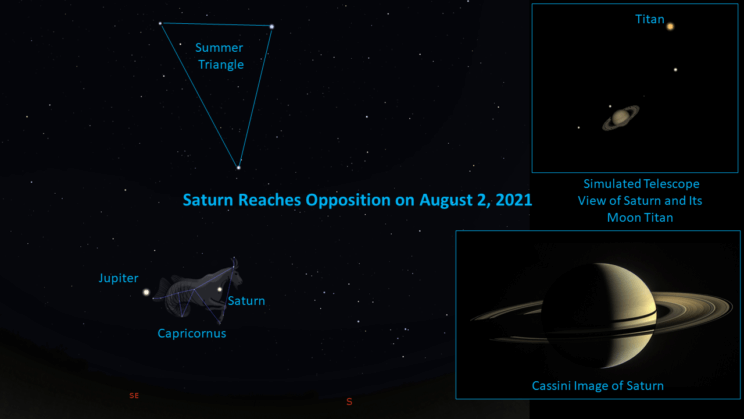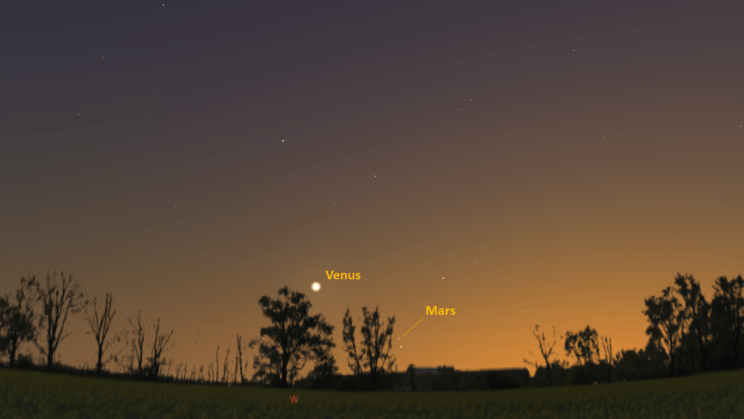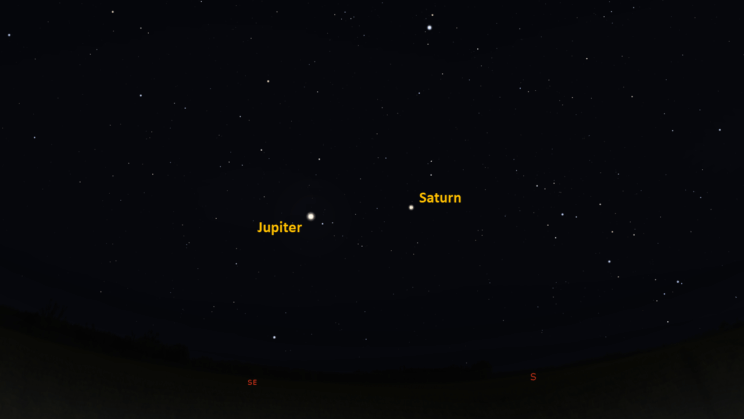This is the Saint Louis Science Center’s NIGHT SKY UPDATE for the week of Friday, July 30, 2021.
Information updated weekly or as needed.
Times given as local St. Louis time, which is Central Daylight Time (CDT). For definitions of terminology used in the night sky update, click the highlighted text. If relying on times posted in Universal Time (UT), St. Louis is -5 hours when CDT.
Public Telescope Viewings
With the changing recommendations from the CDC regarding COVID-19, conversations regarding the return of star parties at the Saint Louis Science Center have begun. We are close to bringing back our public telescope viewings, but a few details still need to be worked out. We will post future updates as we learn more about when we can bring back telescope viewings.
Observing Highlight of the Week

Saturn reaches opposition on August 2, 2021. Look for Saturn rising after sunset in the southeast.
Saturn image credit: NASA; Graphic created using Stellarium
On Aug. 2, the planet Saturn will reach opposition. Opposition occurs when an astronomical body is nearest the point directly opposite the Sun. Another way to state this is an object will appear near the anti-solar point when at opposition. As a result, on Aug. 2, Saturn will be found rising in the southeast as the Sun is setting. Saturn reaches opposition once a year when we catch up to the planet in our orbit. Because Earth is closer to the Sun, it moves faster along its orbit. This allows Earth to catch up to Saturn each year. All of the superior planets reach opposition. Jupiter, Saturn, Uranus and Neptune reach opposition every year, and Mars take 26 months to reach opposition.
During opposition, objects appear their brightest due to the opposition effect. This effect occurs because shadows cast by an object are pointed away from the viewer. This causes us to see more sunlit areas and fewer shadowed regions, resulting in a brighter appearance. This is the same reason that the Moon looks brighter during full moon.
Saturn is currently found in the constellation Capricornus. To find Capricornus, it is best to start with the Summer Triangle. This famous asterism can be found high in the east, almost overhead, at 9:30 p.m. The three stars that make up the triangle are Deneb in Cygnus, Vega in Lyra and Altair in Aquila. Once you can find these stars, follow a line from Vega to Altair continuing southeast until you see a smile shape of stars; this is Capricornus. Saturn is the bright star-like object that will not appear to twinkle.
If you track Saturn for the rest of the year, you will see that after Aug. 2, Saturn will slowly begin to fade. That said, when visible at night, Saturn is always visible to the unaided eye. Saturn is also an excellent target to point a telescope at. Through most telescopes at low magnification, Saturn’s rings are easily seen. Along with its rings, you may catch a view of a few moons of Saturn. Saturn, as of July 2021, has the most moons with 82. The brightest and easiest to see is Titan.
Saturn takes about 29.5 years to orbit the Sun. During this time, you will see Saturn make a trip through each zodiac constellation. Viewing Saturn through a telescope during this 29.5-year period will reveal that Saturn’s rings do not always appear the same. Much like Earth, Saturn is tilted on its axis of rotation. During Saturn’s 29.5-year long orbit, it will experience four seasons like Earth. As Saturn goes through its cycle of seasons, the appearance of the rings will vary from a tilted view to seeing them edge on. The edge-on view occurs as Saturn reaches equinox, which occurs approximately every 15 years. Around the equinox, night falls on the entire ring system for four days. When this happened in 2009, the temperature at the rings fell to -382° Fahrenheit as measured by the Cassini spacecraft. Saturn’s next equinox occurs on May 6, 2025. After this date, the rings will appear more tilted each year until May 2032 when the southern side of the rings will be visible, appearing titled about 27°. Right now, we see the north side of the rings, which appear tilted about 18°.
If you enjoy your time viewing Saturn during its 2021 opposition, keep in mind Jupiter will reach opposition on August 19, Uranus is at opposition on November 4 and Neptune is at opposition on September 14. Mars will not reach opposition again until December 7, 2022.
The Sun and Moon

The Moon as seen from the International Space Station, on July 31, 2011.
Credit: NASA
Sunrise is at 6:01 a.m. on Friday, July 30, and sunset is at 8:13 p.m., providing us with a little over 14 hours of daylight. Even after sunset, the light from the Sun will dimly illuminate our sky for 1 hour and 45 minutes. This period is called twilight, which ends around 9:59 p.m. this week. For those with a sundial, local noon occurs around 1:07 p.m. this week.
| Day | Sunrise | Sunset |
|---|---|---|
| 2021-07-30 | 6:01 a.m. | 8:13 p.m. |
| 2021-07-31 | 6:02 a.m. | 8:12 p.m. |
| 2021-08-01 | 6:03 a.m. | 8:11 p.m. |
| 2021-08-02 | 6:04 a.m. | 8:10 p.m. |
| 2021-08-03 | 6:05 a.m. | 8:09 p.m. |
| 2021-08-04 | 6:06 a.m. | 8:08 p.m. |
| 2021-08-05 | 6:07 a.m. | 8:07 p.m. |
| 2021-08-06 | 6:07 a.m. | 8:06 p.m. |
| 2021-08-07 | 6:08 a.m. | 8:05 p.m. |
Moon
Moonrise for Friday, July 30 occurred at 11:40 p.m. on the previous evening and moonset will occur at 11:44 a.m. On Friday, July 30 the Moon will exhibit a waning gibbous phase with about 56% of the lunar disk illuminated. Last quarter moon occurs on July 31 at 8:16 a.m.
50th anniversary of Apollo 15
July 30, 2021, marks the 50th anniversary of Apollo 15 landing on the Moon. Astronauts David R. Scott and James B. Irwin, landed on the Moon aboard the lunar module Falcon on July 30, 1971 at 22:16 UTC. Meanwhile Astronaut Alfred M. Worden stayed aboard the command module Endeavour. Apollo 15 landed near Hadley Rille which is near the Apennine Mountains on the east edge of Mare Imbrium. Apollo 15’s mission duration was 12 days, 7 hours and 11 minutes.
International Space Station (ISS) Observing

Visible passes of ISS from St. Louis for the week of July 30 occur during evening hours. The best passes this week occur on the evenings of August 1 and 2. Use the table below for information about this and other visible passes this week.
Catch ISS from St. Louis starting Friday, July 30
| Date | Starts | Max. altitude | Ends | |||||||
|---|---|---|---|---|---|---|---|---|---|---|
| Time | Alt. | Az. | Time | Alt. | Az. | Time | Alt. | Az. | ||
| 30 Jul | -3.1 | 21:37:35 | 10 | NW | 21:40:50 | 45 | NE | 21:42:08 | 29 | E |
| 31 Jul | -2.3 | 20:50:24 | 10 | NNW | 20:53:25 | 29 | NNE | 20:56:26 | 10 | E |
| 31 Jul | -2.1 | 22:27:12 | 10 | WNW | 22:29:32 | 28 | WSW | 22:29:32 | 28 | WSW |
| 01 Aug | -3.4 | 21:39:39 | 10 | WNW | 21:42:59 | 56 | SW | 21:44:02 | 36 | SSE |
| 02 Aug | -3.7 | 20:52:17 | 10 | NW | 20:55:40 | 80 | NE | 20:58:35 | 13 | SE |
| 03 Aug | -1.5 | 21:42:31 | 10 | W | 21:44:51 | 17 | SW | 21:46:11 | 14 | SSW |
| 04 Aug | -2.2 | 20:54:38 | 10 | WNW | 20:57:39 | 30 | SW | 21:00:38 | 10 | SSE |
Magnitude (Mag): The Measure of brightness for a celestial object. The lower the value is, the brighter the object will be.
Altitude (Alt): The angle of a celestial object measured upwards from the observer’s horizon.
Azimuth (Az): The direction of a celestial object, measured clockwise from an observer’s location with north being 0°, east being 90°, south being 180° and west being 270°.
For information about ISS flyovers and other visible satellites, visit www.heavens-above.com
Detailed information regarding all unmanned exploration of our universe, missions past, present, and planned, can be found at Jet Propulsion Laboratories:
The Visible Planets

Looking West, at 8:45 p.m. July 30, 2021
Credit: Stellarium, EG

Looking Southeast, at 10:00 pm, July 30, 2021
Credit: Stellarium, EG
This week, four naked eye planets are visible. Venus and Mars can be found in the west after sunset. Jupiter and Saturn can be found in the southeast by 10:00 p.m.
Venus
Venus is well into another evening apparition. By 8:50 p.m., Venus will be about 10.5° above the western horizon. As 2021 continues, we will see Venus climb higher in the western sky after sunset until October 29 when it reaches maximum eastern elongation. After this date Venus will start to head back towards the Sun as it approaches inferior conjunction on January 8, 2022.
Mars
Currently Mars appears as a 1.8-magnitude object that will be visible in the west about 30 minutes after sunset. Mars is appearing close enough to the Sun that the light of twilight is making it difficult to see the planet without the aid of binoculars. Mars sets by 9:17 p.m. Mars is headed towards superior conjunction on October 7, 2021. As we get closer to this date, Mars will set earlier each night until we lose the Red Planet to the glare of the Sun.
Jupiter
Jupiter is now rising before midnight. Jupiter rises at 9:15 p.m. and will be easy to see in the southeast by 10:15 p.m.
Saturn
Saturn has returned to our evening sky. Saturn rises at 8:18 p.m. and will be easy to spot by 9:30 p.m. looking southeast. Saturn will reach opposition on August 2. This week Saturn will appear its brightest for the year.
James S. McDonnell Planetarium
Night Sky Update: July 30-August 7, 2021






